Easy Homemade Dill Pickles
These easy homemade dill pickles are perfectly crisp, tangy and refreshing. They are seasoned with just the right amount of dill and garlic. Whether you’ll serve them with hot dogs, hamburgers or simply enjoy as a snack, they will be good for up to a year in your pantry. For a sweeter version, try these sweet and spicy pickles.
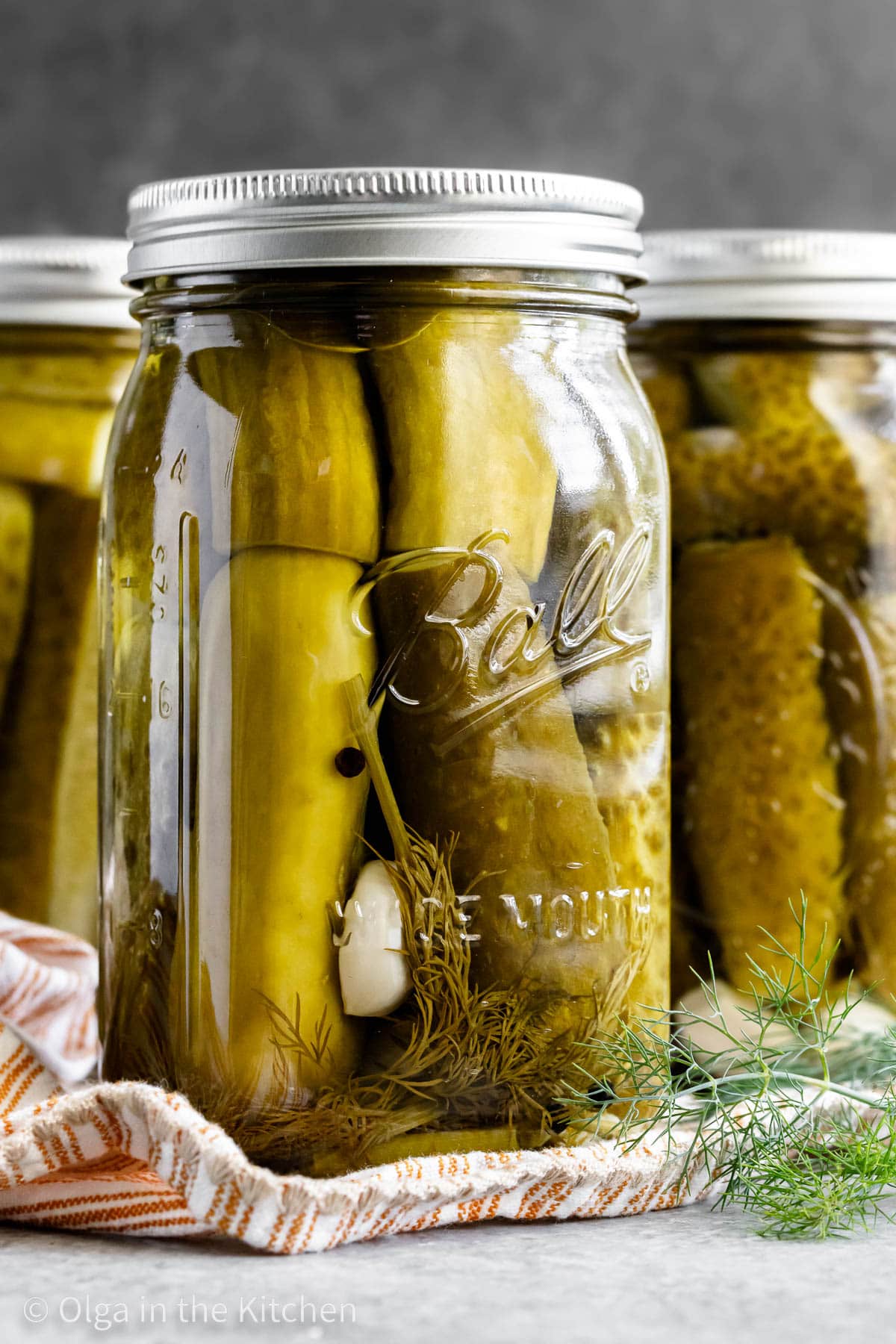
This post may contain affiliate links. Read my disclosure policy.
Dill Pickles Recipe
This recipe is for making shelf stable pickles, meaning they can be stored in your pantry, sealed for up to a year. Our aunt Sveta shared this recipe with us this summer and mentioned how everyone who ate them, really enjoyed every bite. They are so easy to make and remind me a lot of the Nalley brand dill wholes pickles I always buy at the grocery store.
With their tangy flavor and crunchy texture, dill wholes pickles work great in Olivye Salad and Vinaigrette Salad. It also saves you a trip to the store when you’re in need of some tangy pickles to snack on or use as an ingredient in a salad.
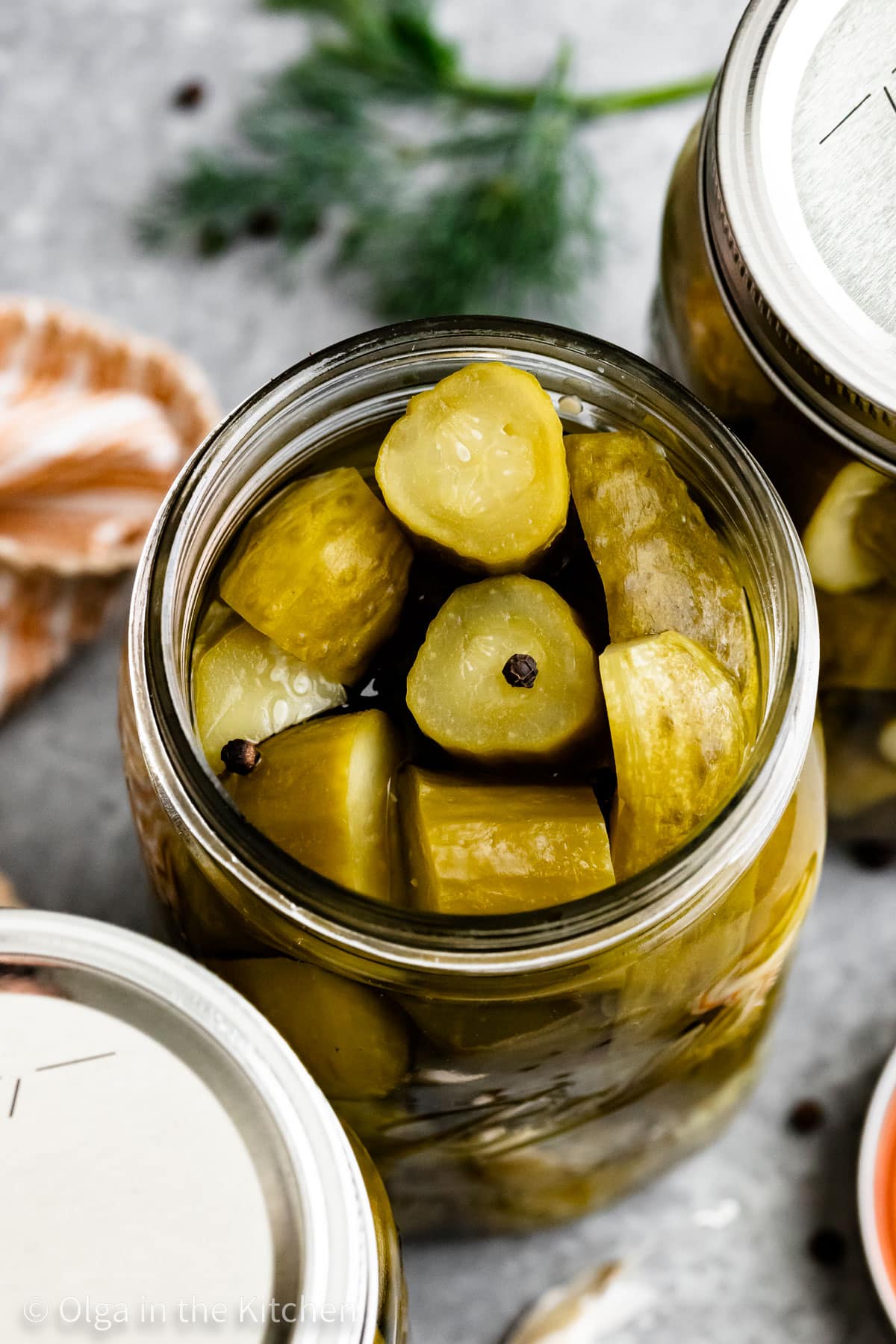
Here’s Why You’ll Love These Homemade Pickles
- Flavor: Dill pickles have the perfect balance of salty and tangy with a touch of sweetness. With fresh dill and garlic in addition, all the flavors combined make these pickles some of the very best pickles you will eat. Try putting these pickle chips onto sprats canapes and it will become your next favorite appetizer!
- Texture: Crispy and the same texture as our sweet and spicy pickles. Not over-processing will keep these pickles crisp until ready to eat, whether weeks later or months later. Remember that any size works – wholes, chips or spears. They all turn out amazingly delicious!
- Ease: If you’re new to home canning, it can seem intimidating at first, but this method is very easy, and the recipe below is packed with thorough details so you can be confident in the kitchen. You’ll quickly see how easy it is to preserve your vegetables and make them last in your pantry up to a year.
- Time: Packing jars with cucumbers certainly takes time, but if you ever tasted homemade dill pickles, I think you’ll agree they’re worth it! If you follow this recipe without doubling it, the process shouldn’t take you longer than 2 hours, start to finish. If canning whole cucumbers, it will be even faster. Chips and spears take a bit more time to pack into jars to fill those empty spaces.
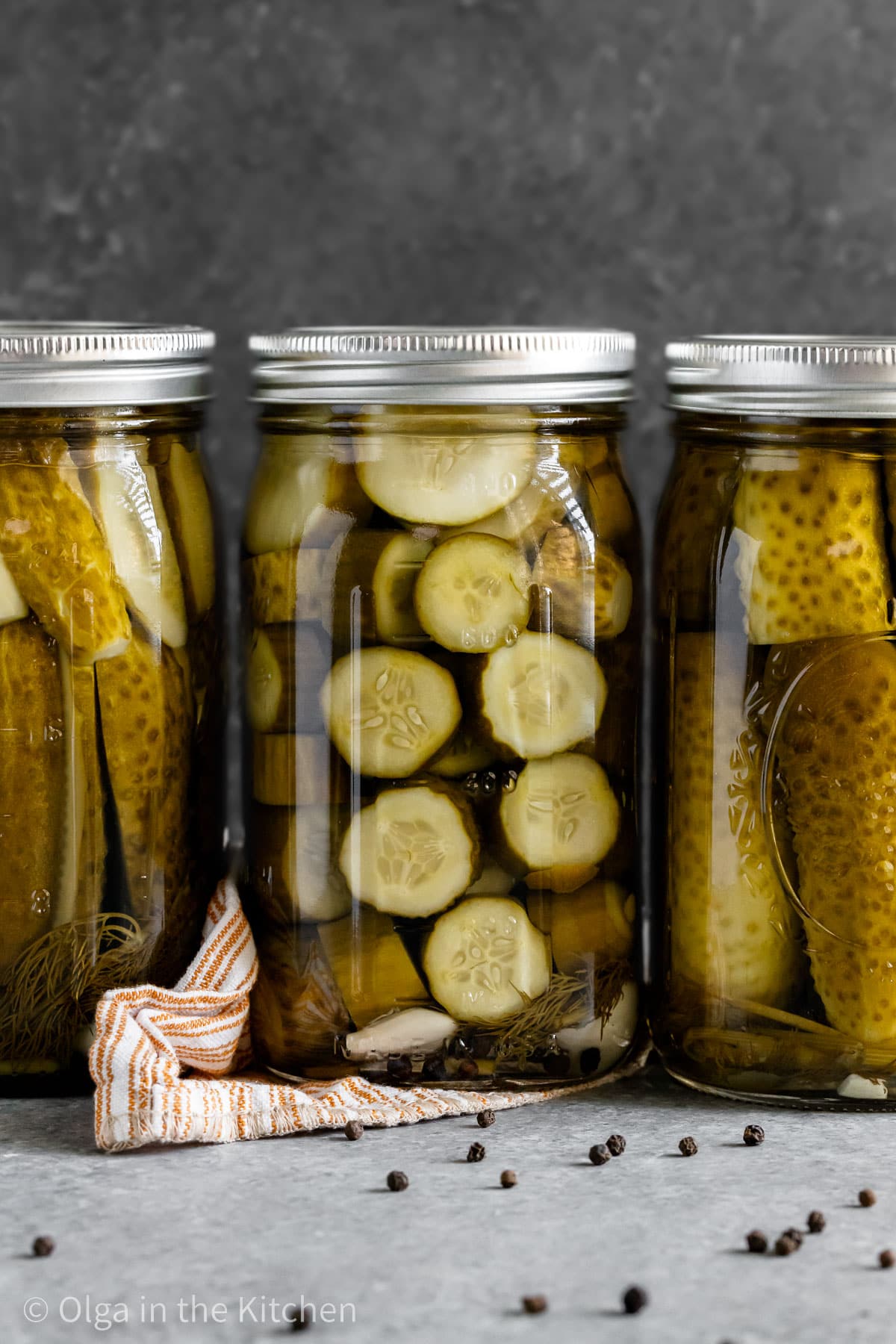
Grab These 9 Ingredients:
- Cucumbers: Use smaller 4 to 5-inch pickling cucumbers to can as wholes or cut larger cucumbers into chips or spears.
- Water: You need a good amount of water for the brine and more water to fill the pot for processing jars with cucumbers.
- Distilled White Vinegar: A good old-fashioned white vinegar of 5% or 6% acidity works best.
- Granulated Sugar: The sugar doesn’t make the pickles sweet, instead it balances the vinegar and salt to create an irresistible sour dill pickle flavor.
- Fine Salt: Regular fine salt works just as much as pickling salt and it’s the one most or all of you have in your kitchens already.
- Fresh Dill: If you can find dill heads (also called dill umbrella) use it. If not, regular twigs of dill work great. Just snap or bend twigs to fit at the bottom of each jar.
- Fresh Garlic: For extra flavor, add 2 larger garlic cloves per jar.
- Black Peppercorns: Whole peppercorns are best to use in this recipe because they have milder taste compared to ground pepper.
- Bay Leaves: Bay leaves bring extra flavor to the pickles. You will taste a strong bay leaf flavor in the brine at first, but once the cucumbers are canned and rested, it won’t be that strong.
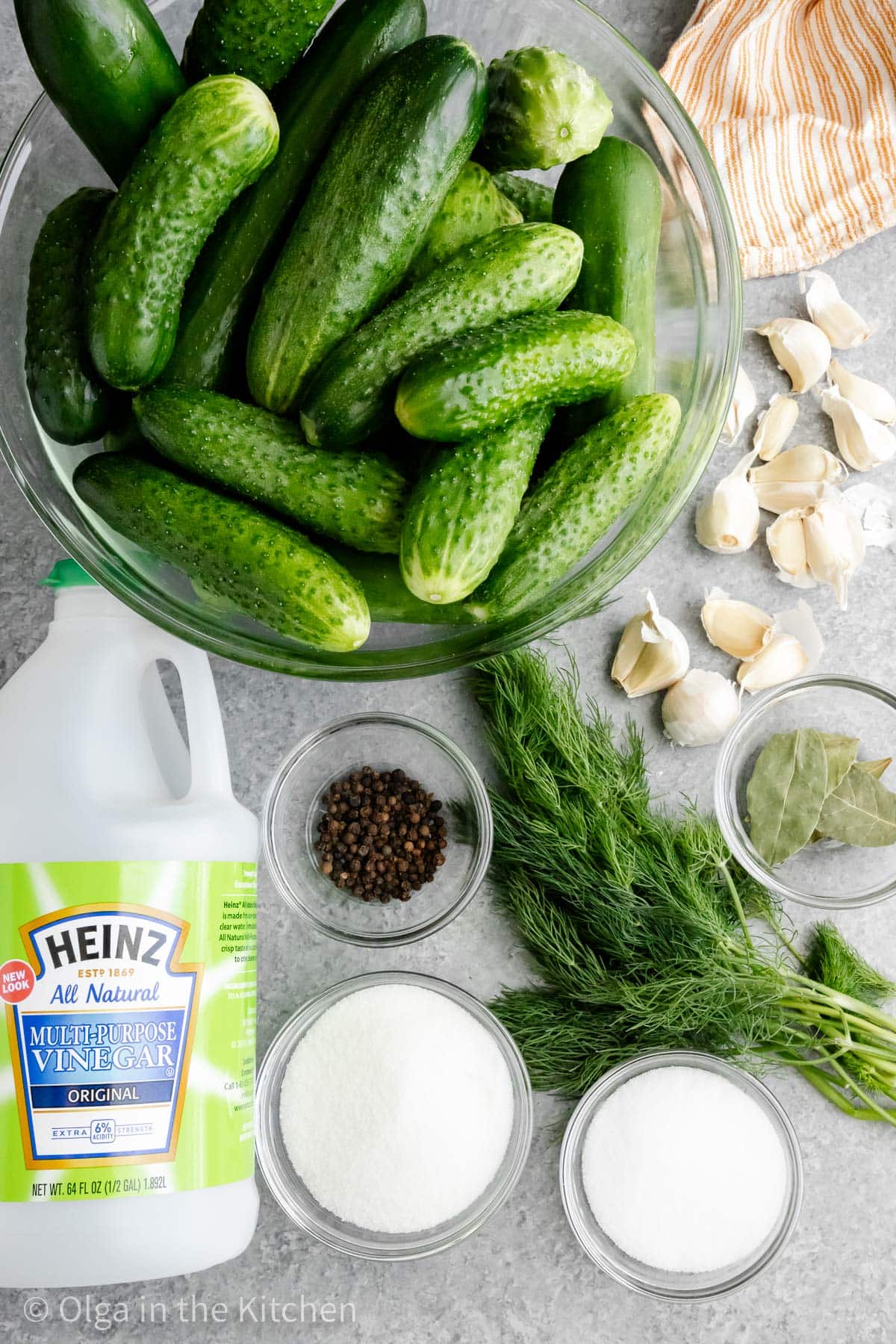
Home Canning Tools Needed:
- 32 oz sized (wide-mouth) Mason jars with rings and new lids
- Large stock pot (20qt+)
- A towel to line at the bottom of the pot (if not using rack)
- Jar lifter to safely transfer the jars
Best Cucumbers to Use
While many recipes suggest pickling cucumbers for making homemade dill pickles, I say all work because I’ve experienced it. It doesn’t matter what cut of cucumbers you make, it’s a matter of preference.
Just keep in mind, that larger cuts like whole pickles or spears will hold up better over time if you’re planning to keep these for up to a year.
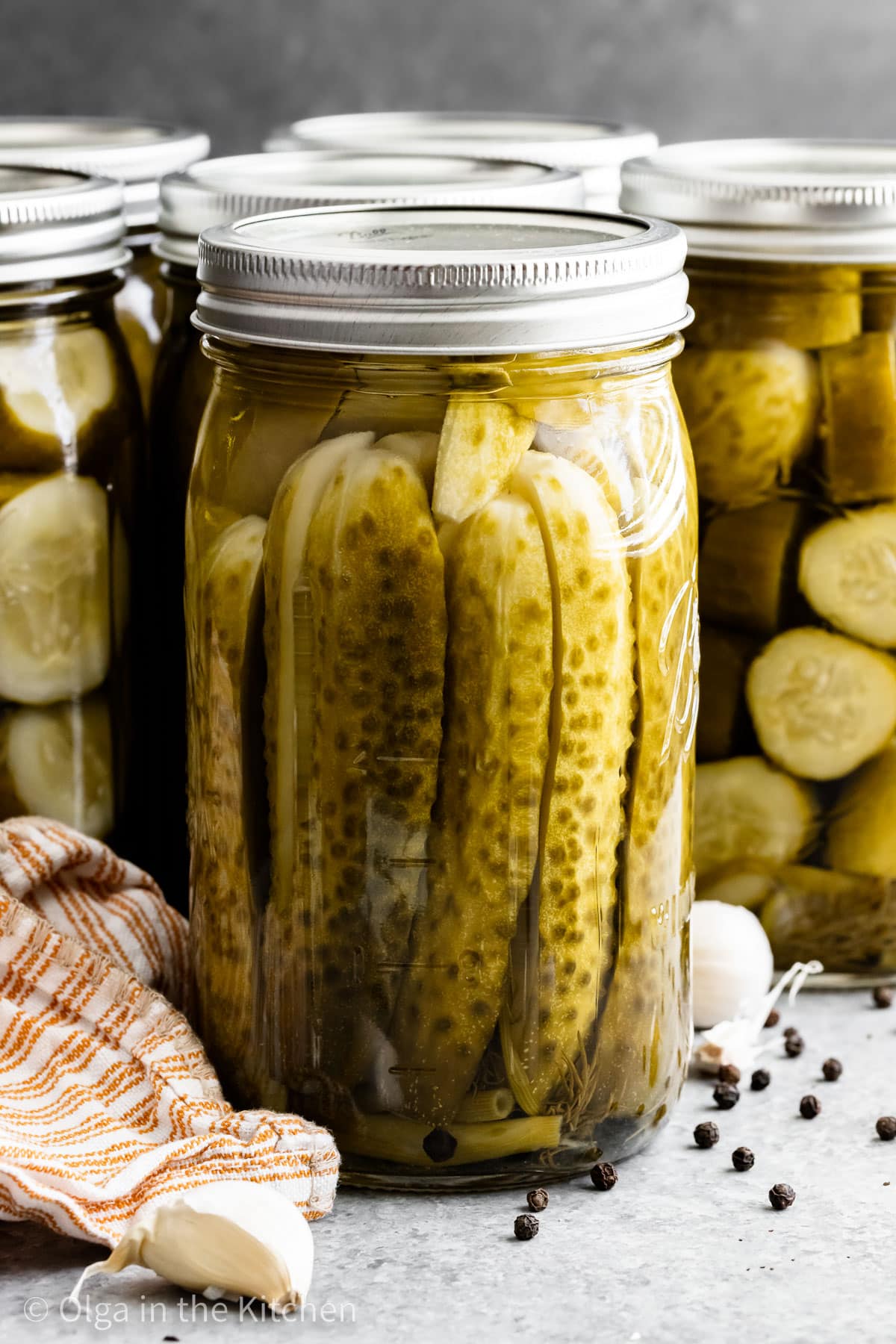
Overview: How to Make Dill Pickles
- Sterilize Jars: Wash all jars and lids with warm soapy water. Sterilize the lids fully submerged in water for 4-5 minutes after the water starts boiling; carefully paper towel pat dry lids. Preheat the oven to a 215°F and place jars upside down onto oven racks. Dry jars for 20 minutes or until completely dry.
- Make Pickling Brine: In a large pot, combine and stir water, vinegar, sugar, salt and toss in 5 bay leaves. Bring to a boil, remove from heat making sure salt and sugar are dissolved.
- Fill Jars: Wash and cut off both ends of the cucumbers. Fill the bottom of each jar with couple twigs of fresh dill, garlic cloves and black peppercorns. Tightly pack jars with cucumbers. Slowly pour the pickling brine into jars over cucumbers, up to the rim (leaving 1/2-inch of space at the top), and cover with lids, but do not close.
- Process the Jars: Place packed jars into the canning pot lined with a towel or rack and fill with water, about 2 inches below jars. Bring to a boil over medium-high heat, then reduce heat to low and process jars for about 15 minutes or until cucumbers turn light green.
- Seal the Jars: Remove the jars from the water, close lids tightly and flip jars upside down. Cover jars with bath towels or blankets. Allow them to sit at room temperature undisturbed for 12-24 hours. Store pickles in a cool place for up to a year.
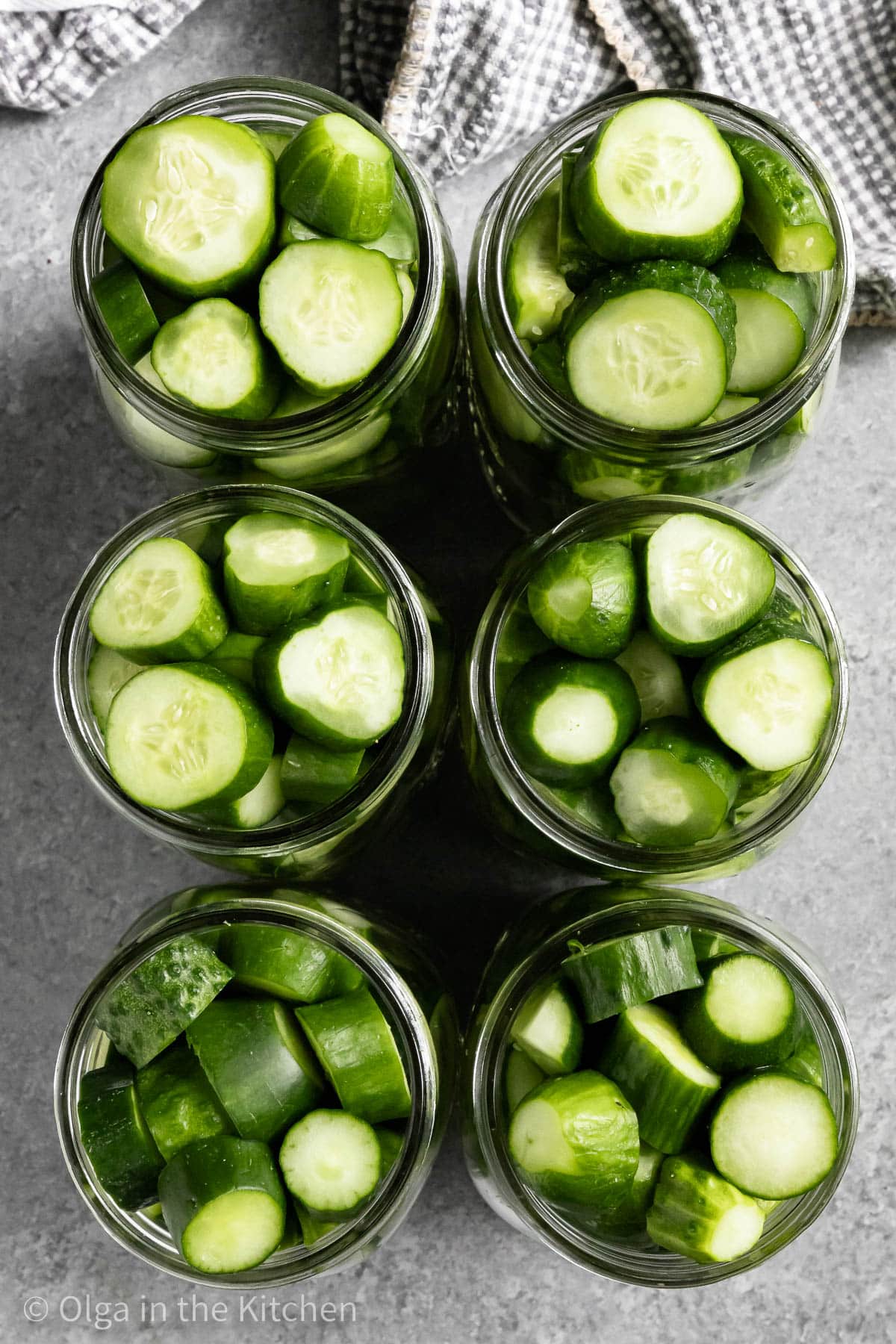
Signs of Spoiled Canned Pickles
With any type of food canning, when in doubt – throw it away. Discard canned food If you notice any of the following:
- The jar is leaking or bulging
- The jar looks cracked, damaged or unusual
- The jar spurts liquid or foam upon opening
- Canned food is discolored, slimy, smells bad or moldy
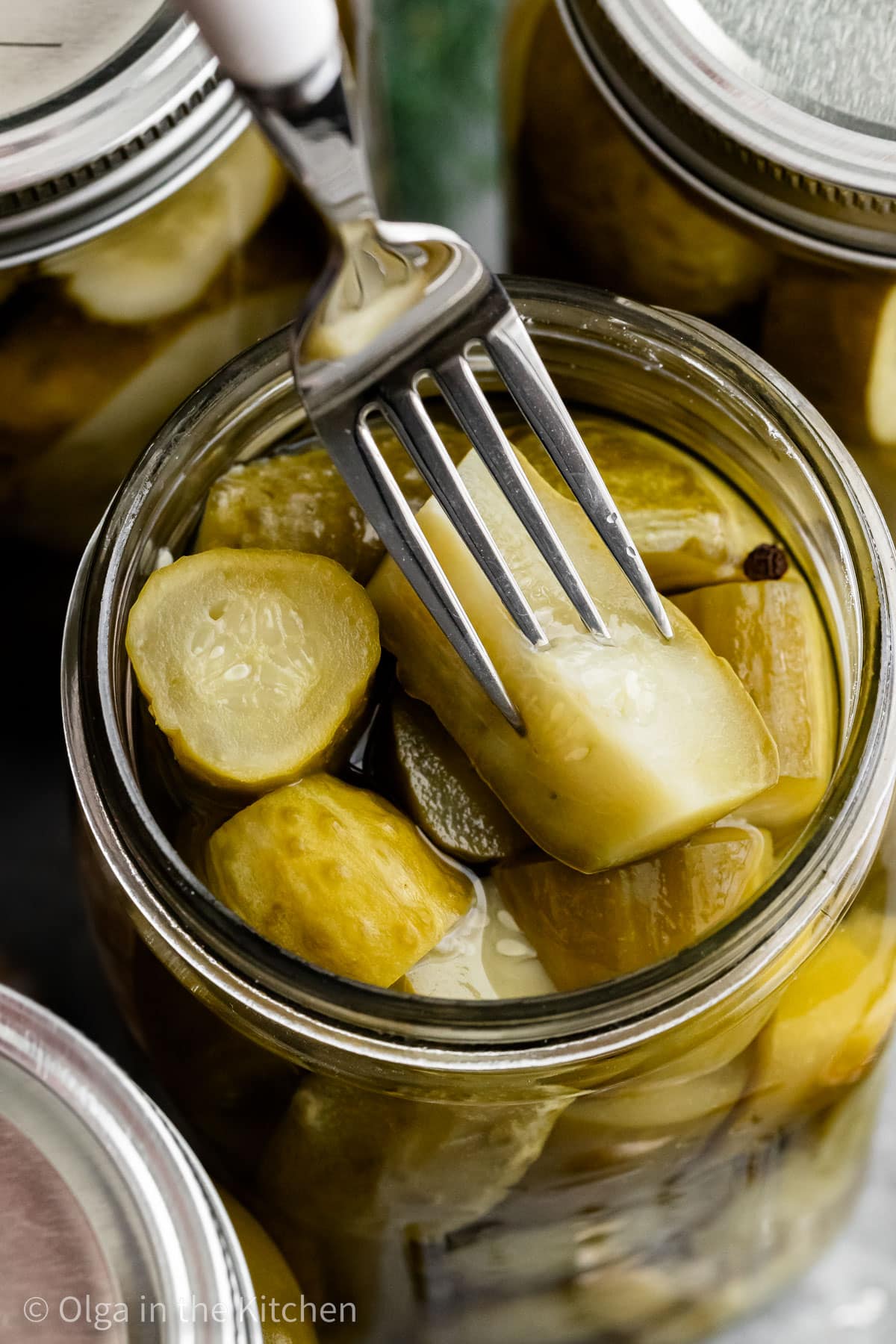
More Garden Vegetables Salads You’ll Love:
- Pickled Salad Autumn
- Green Cabbage Cucumber Salad
- Quick Tomato Salad
- Creamy Broccoli Cauliflower Salad
- All-Veggie Salad
- Lettuce Radish Salad
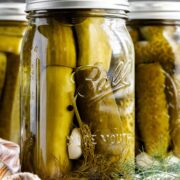
Easy Homemade Dill Pickles
Ingredients
- 12 pounds cucumbers* (approximately), well rinsed with ends trimmed
- 1/2 tablespoon peppercorns, (5 per jar)
- 16 garlic cloves (2 per jar)
- fresh dill, 2-3 twigs per jar
Pickling Brine
- 12 cups (3,000 ml) water (cold or lukewarm)
- 2 cups (500ml) distilled white vinegar, (5% or 6% acidity)
- 2/3 cup (200g) fine salt
- 1/2 cup +1 tablespoon (115g) granulated sugar
- 5 bay leaves
Instructions
- Sterilize Jars: Wash all jars and lids with warm soapy water. Sterilize the lids fully submerged in water for 4-5 minutes after the water starts boiling; carefully paper towel pat dry lids. Preheat the oven to a 215°F and place jars upside down onto oven racks. Dry jars for 20 minutes or until completely dry.
- Make Pickling Brine: In a large pot, combine and stir: 12 cups water, 2 cups vinegar, 1/2 cup sugar, 2/3 cup salt and toss in 5 bay leaves. Bring to a boil, reduce heat to low and boil for 5 minutes. Remove from heat making sure salt and sugar are dissolved and let it rest 10 minutes, then discard the bay leaves.
- Fill Jars: Wash and cut off both ends of the cucumbers. Fill the bottom of each jar with couple twigs of fresh dill, garlic cloves and black peppercorns. Tightly pack jars with cucumbers. Slowly pour the pickling brine into jars over cucumbers, up to the rim (leaving 1/2-inch of space at the top), and cover with lids, but do not close. A 1/4 measuring cup works great for pouring pickling brine.
- Process the Jars: Line a kitchen towel or a microfiber towel at the bottom of the pot if not using rack. It is very important that the bottom of jars are not touching directly the pot or jars will crack when heated. Place packed jars into the canning pot and fill with warm water, about 2 inches below jars. Cover with lid, bring to a boil over medium-high heat, then reduce heat to low and process/boil jars for about 15 minutes or as soon as cucumbers turn light green.
- Seal the Jars: Carefully remove jars one by one from the water using jar lifter and tightly close lids (use kitchen towel or rubber oven mitt for best results). Flip the jars upside down and cover them with bath towels or blankets as soon as you flip them over (the more layers the better). Allow them to sit at room temperature undisturbed for 12 to 24 hours. You may hear a pop when the jars fully seal. Store pickles in a cool place.
Notes
- Cucumbers: The amount of cucumbers needed is based on whether you are canning whole cucumbers or sliced. Tightly packed jars will require less pickling brine, but the cucumbers will still marinate properly. You will end up with less or more than 8 (32oz) jars - it all depends on what size you cut the cucumbers and how tightly you pack the jars.
- Metric Measurements: water is 2,880ml and vinegar is 480ml. In ingredients above, we rounded to the nearest round number for easier measuring. Both metric amounts work, just follow one or the other.
- How to Test if Canning Seal Has Formed? When you push in the center of the lid, it should not pop up and down. If you're hearing popping or clicking, the seal did not form and the jar must be refrigerated. We never had it happen, but just in case, we want you to know what to do.
- Pickling Brine: You can make the brine a day ahead, cool to room temperature and refrigerate. Allow the brine to come to room temperature while you pack jars with cucumbers.
- Trim: Trimming cucumber ends is mandatory. The ends carry a ripening enzyme that promotes softening even after they’re pickled.
- Over-processing: If you keep cucumbers for too long in the water bath, they will become soft. They will continue cooking once out, underneath the blanket of towels.
- Storing Cucumbers: When canned properly and stored in a cool place, homemade pickles can keep for up to 1 year at room temperature. Once you break the seal, make sure to store them in the refrigerator for up to a month.

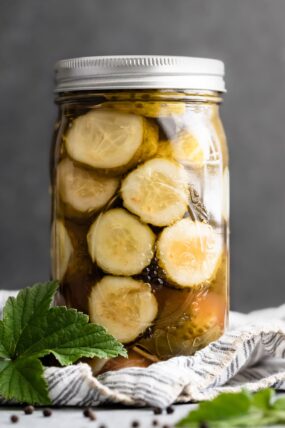
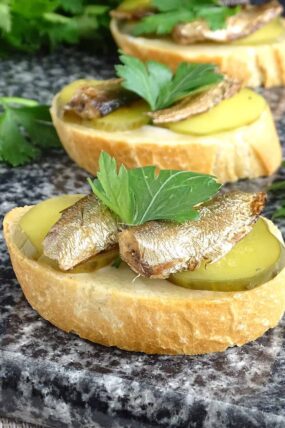
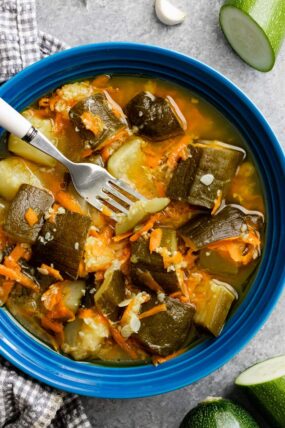
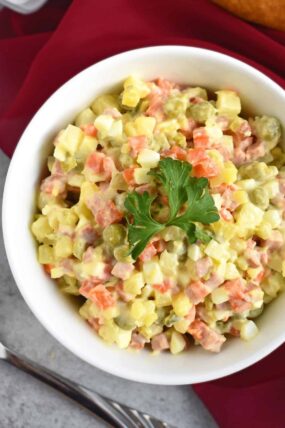
Gary says:
I tried this recipe and the taste was fantastic but the pickles were soft and mushy. Any idea on why they didn’t turn out crunchy?
Olga in the Kitchen says:
That means you overcooked them. You want to take them out the moment no more fresh green color is visible and not cook any minute longer, otherwise the more you keep them boiling, the softer they will get.
Marisol says:
I love your recipe! Your brine recipe is my favorite! It’s not too salty or extremely sour, just the right amount of everything. I’m replacing my other recipe and keeping yours.
Olga in the Kitchen says:
That’s great to hear, Marisol! I’m so glad you enjoyed these.
Louise says:
Question, for the water bath.. put on the lids then screw ring to hold on the lids correct. In the instructions it says do not close? Do you bring the water level up to just under the screw rings? Or cover with atleast 1 inch over tops?
Olga in the Kitchen says:
Hi Louise! While the jars are heating in the water bath, you place the lids with rings on top to keep the heat inside the jars, but do not screw it on while it’s heating. Fill jars with pickling brine up to the rim (leaving 1/2-inch of space at the top).
Louise F. says:
Hi Olga, in steps 3, Fiĺl Jars… says put lids on but do not close. Step 4 Process the Jars, says put warm water 2 inches below jars. Step 5 Seal the Jars, says to tighten lids after removing from the hot water? Maybe I’m misunderstanding with bit of language issue. I just threw out 15 pints of Dill pickles made bit ago from different site. The brine was much too tangy so I’ve looked at this recipe and compared your brine to other recipe and see that there is a big difference. I will be making your recipe which I want to turn out. So do I fill the jars with cucumber and brine, then lid and ring, finger tighten so air can escape during water bath, put jars in water bath with water covering top of jars with atleast 1 inch water? Also my Grandmother always said do not tighten rings more after processed in water bath as may move lid and break the seal. Is this what you are explaining? Sorry to be making lots of questions for explanation, I don’t want to do wrong and end up throwing out again is all. Make pickles, jams and relish, my 1st time for Dills tho. Thanks
Olga in the Kitchen says:
Hi Louise! Please see a photo in this other pickle recipe Homemade Sweet and Spicy Pickles where it shows how to put the lid on. You do not tighten the lid while the cucumbers are in the pot. You simply place them on top to keep the heat in (same as you would put a lid on a pot when you’re making soup, for example) and to warm up/sterilize the lids. I don’t know about other pickles recipe, but we do not close the lids while the jars are in the water bath. You use a jar lifter or thick oven mitt to remove the jars ones pickles changed color and quickly tighten the lids as much as you can. Pay attention to step 4, making sure you have a thin towel or microfiber towel so that jars don’t touch the pot directly or it will crack the jars. Hope this helps!
Louise says:
How long before they are ready to eat?
Olga in the Kitchen says:
We eat them months later usually in late fall/winter, but if you want to enjoy sooner, give them a week at least.
Martha S says:
Thank you for sharing this recipe! We canned 50 lbs of cucumbers last week and opened a jar to taste these today. They had the perfect crisp, perfectly flavored and so great for snacking too. The recipe has very easy instructions to follow, very helpful. I will now use only this recipe for making homemade dill pickles. It is the best dill pickle recipe I tried over the years! Now I’m going to jar your spicy version as well. Thank you for sharing Olga!
Olga in the Kitchen says:
That is amazing! Thank you for this wonderful review, Martha!
rita p says:
I made your dill pickle recipe and it is delicious. They are so crunchy, very easy to make! My husband and I say this is definitely a keeper!! Thank you!
Shelly says:
Simple recipe and so tasty. This will be my go too.
Kelley says:
These are great! I made a jar and they were a hit with the family so I made two more, now I need to buy more ingredients.
Olga in the Kitchen says:
So happy to hear you enjoyed this recipe, Kelley!
Jess says:
We love this recipe, it’s our favorite. My husband only eats tangy pickles, he won’t eat sweet ones so we canned 10 jars of this recipe so far but will be doing more over the weekend.
Olga in the Kitchen says:
So happy to hear you guys enjoyed this recipe! 🙂